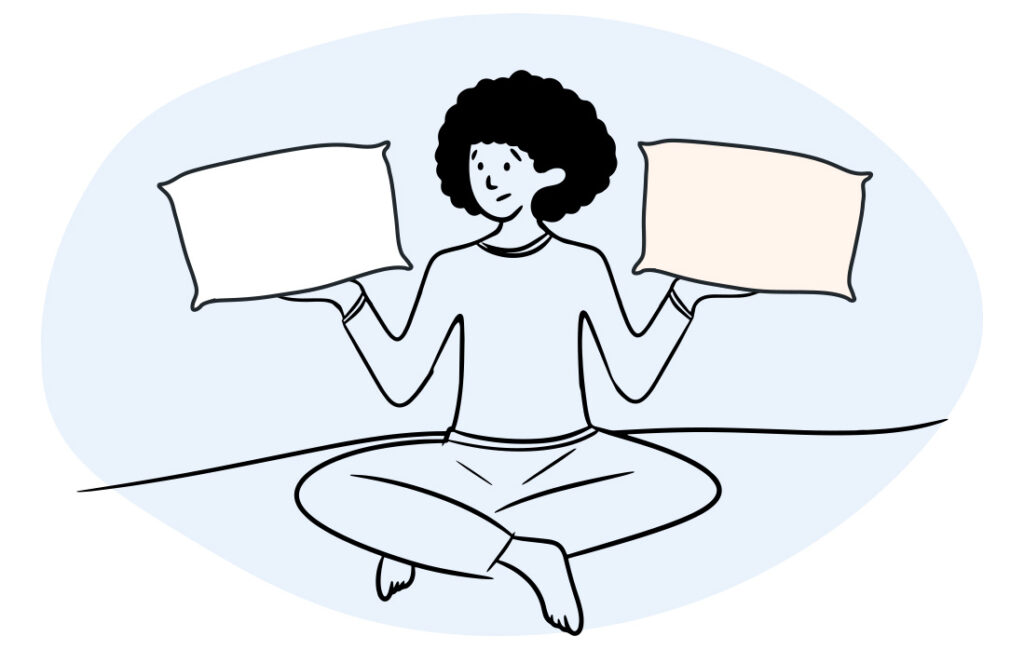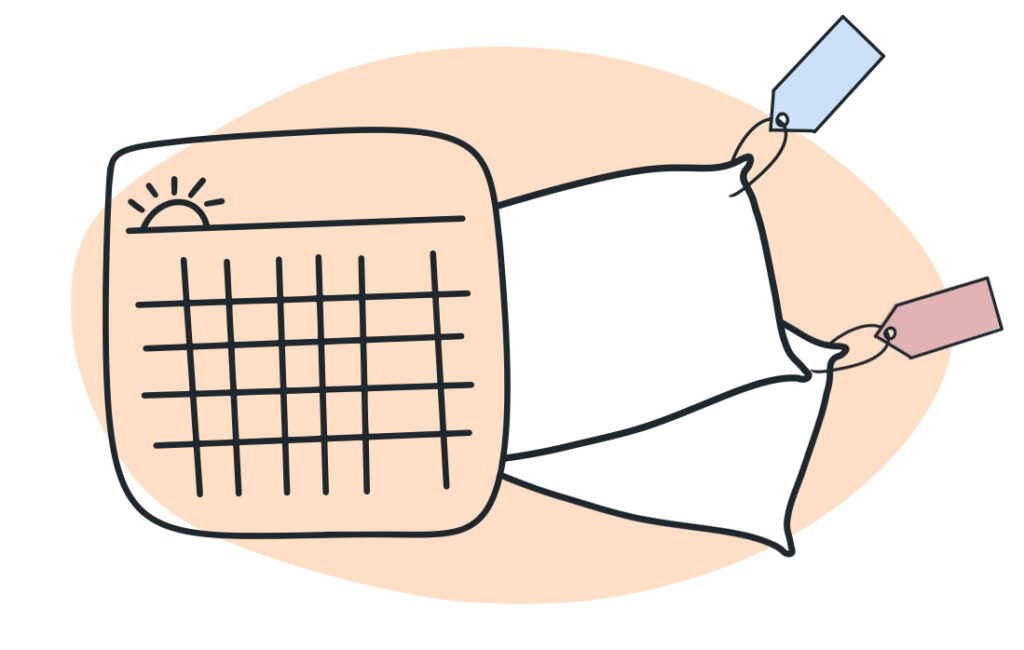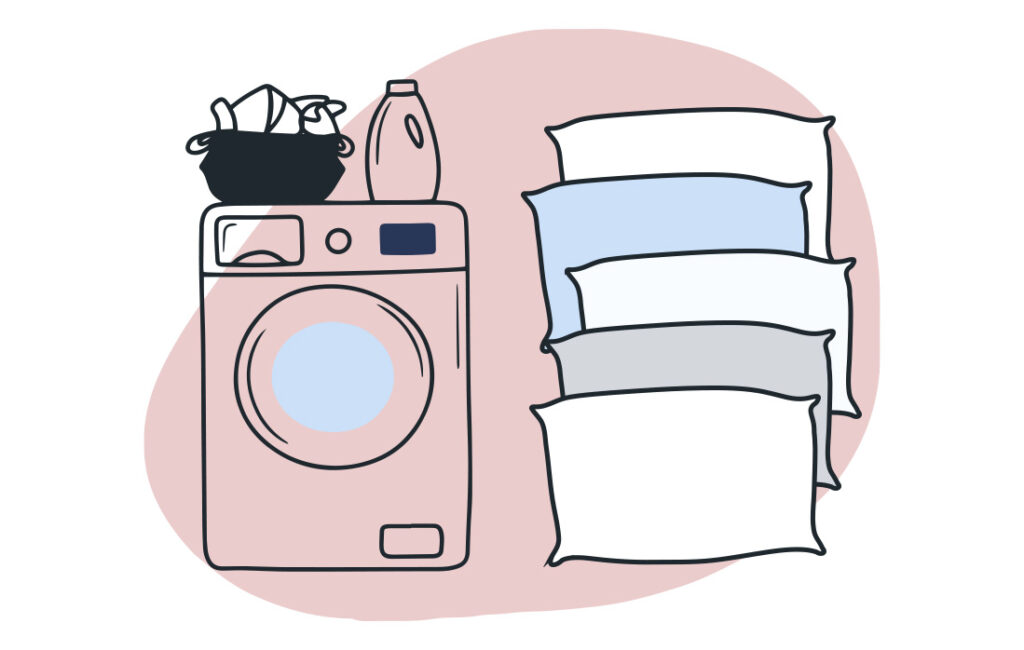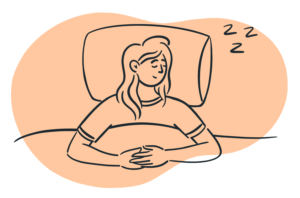Why Do My Pillows Turn Yellow?
Disclosure: By clicking on the product links in this article, Mattress Nerd may receive a commission fee at no cost to you, the reader. Read full disclosure statement.
Picture the perfect pillow. You’re probably imagining a fluffy, white pillow – not a stained, yellow one. But is there anything wrong with a pillow that’s turning yellow?
We’re getting to the bottom of what can cause those yellow stains, how to get rid of them, and when it’s time to replace your pillow.

Why Do Pillows Turn Yellow?
Dealing with pesky yellow stains? Recognizing the most likely culprits can help you prevent future stains and prolong your pillow’s lifespan.
1. You Sweat In Your Sleep
One of the most common causes of yellow pillow stains is sweat. Unless night sweats are disrupting your quality of rest, this isn’t an issue to be concerned about. It’s normal for sweat to seep through your pillow and accumulate over time, causing yellow stains.
2. You Sleep With Your Hair Wet
Taking a shower before bedtime is a common routine for a lot of people. However, if you don’t wait for your hair to air dry or blow dry it before hopping into bed, your pillow will soak up the moisture in your hair. That can gradually lead to yellow stains and facilitate fungal build-up.
3. You Drool In Your Sleep
Drooling while you’re asleep is nothing to be embarrassed about. Plenty of people drool in their sleep, especially those who are side sleepers or stomach sleepers. This doesn’t tend to be a major contributor to yellow stains, but drool can still cause discoloration and unpleasant smells.
4. You Use Facial Or Beauty Products
If you have a nightly beauty routine, you’re likely to encounter yellow stains more often. When you toss and turn in your sleep, some of the product on your face may transfer onto your pillow and cause stains. Pillow stains also occur if you’re in the habit of sleeping with your makeup on.
Is It Okay To Sleep On A Pillow With Yellow Stains?
It depends on the level of staining with your pillow. As long as your pillow is still supportive, it should still be in the clear to use. On the other hand, allergens and dust mites tend to accumulate especially if washing your pillow has been on the back-burner in your to-do list. If your pillow has a couple stains here or there, it’s probably fine to keep using it. But if it’s become completely yellow or even brown, think about replacing your pillow.

How To Wash Yellow Pillows
Some pillows just need a spin in a washer to clean. However, depending on the material of your pillow, you may need to follow extra steps to wash your pillow. It’s important to follow the product-care tag that comes with your pillow.
Machine-Wash Pillows
If your pillow is machine-washable, you can use a stain-removal spray and concentrate on the worst stains. Follow the product’s instructions and let it sit for the recommended amount of time before putting it into the washer.
Spot-Clean Pillows
If your pillows aren’t fit for the washer (like memory foam pillows), it’s best to spot-clean them. You can use a stain-removal spray, mild laundry detergent, or undiluted white vinegar. Just dab the product on the stains, leave it for 10 to 15 minutes, and wipe it clean with a damp towel. Repeat as many times as necessary.
Use Oxygen Bleach, Not Chlorine Bleach
Now, you may be tempted to reach for your trusty bleach to get rid of those stains. Before you do that, make sure that it’s oxygen bleach and not chlorine bleach. Chlorine bleach may have the opposite effect — instead of making stains lighter, it can react to the proteins in sweat and oil stains and make them darker.
How To Prevent Pillows From Turning Yellow
There are many things you can do to keep those stains away.
- Wash your pillow regularly. The simplest way to combat yellow stains is to wash your pillows (and other bedding items) regularly. Regular washing helps avoid the build-up of all kinds of nasties, like bacteria, oils, dead skin, mold, and dust mites. While you’re at it, don’t forget to clean your mattress, too.
- Use a pillowcase or pillow protector. This can serve as a barrier between your pillow and any sweat and body oils. Make sure to wash the protector regularly as well.
- Dry your hair before sleeping. Not only does it help prevent yellow stains, but it’s also a good habit for your hair health.
- Remove all makeup before bed. No skincare routine is complete without thorough makeup removal. This is also good practice for preventing breakouts and other skin issues.
- Apply skincare products 1-2 hours before bedtime. This gives your favorite night cream enough time to dry, which helps prevent product from transferring to your pillow.

How Often Should You Replace Pillows?
If your pillow is a dark yellow or if some stains don’t come out in the wash, those may be signs that you should start looking for a replacement pillow.
Also, if you start noticing small reddish or black stains, that’s an even clearer indication for you to switch out your pillow. Dark spots are a tell-tale sign of bed bugs, which are drawn to moist and humid spots. If you suspect your home may have bed bugs, take action right away.
Frequently Asked Questions
Are yellow pillows bad?
Not at all. It’s very common for pillows to turn yellow. That’s because it’s natural for your body to sweat and produce natural oils, even in your sleep. Spot treating and washing your pillow should help minimize or remove these stains.
Can you sleep on a yellow pillow?
Yes, it’s okay to sleep on a yellow pillow as long as your pillow is still comfy and provides adequate support for your head and neck. Yellow stains on pillows are common and most can be washed out.
Should I throw away a yellow pillow?
Not so fast. You can still remedy the situation by washing or spot-cleaning your pillow. But if the entirety of your pillow is yellow or you start noticing darker stains, it may be time for a new one.
Takeaway
Yellow stains on your pillow are natural and very common. These are mostly caused by the build-up of sweat, body oils, and moisture. If left unattended, these yellow stains can lead to mold growth and invite bacteria, dust mites, and bed bugs. To avoid this, you should wash your bedding regularly and work toward healthy nighttime habits.
Source List
Aggarwal P, et al. (2022). Dust Mite Allergy. https://www.ncbi.nlm.nih.gov/books/NBK560718/


